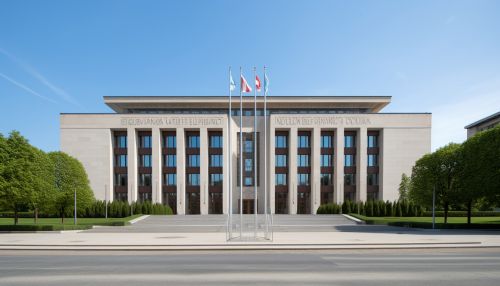League of Nations
Origins and Formation
The League of Nations was an intergovernmental organization founded on 10 January 1920 as a result of the Paris Peace Conference that ended the First World War. It was the first international organization whose principal mission was to maintain world peace. Its primary goals, as stated in its Covenant, included preventing wars through collective security and disarmament, and settling international disputes through negotiation and arbitration.
Covenant of the League of Nations
The Covenant of the League of Nations was the charter of the League of Nations. It was signed on 28 June 1919 as Part I of the Treaty of Versailles, and it became effective together with the rest of the Treaty on 10 January 1920. The Covenant consisted of 26 articles. Articles 1 to 7 concerned organization and structure, articles 8 to 13 were related to military and naval matters, while articles 14 to 25 dealt with various political and economic issues.


Membership
The League of Nations had 58 member countries at its height in 1920. The first 42 member states included the British Empire, France, Italy, and Japan. The United States, despite having been one of the Allied Powers during the First World War, did not join the League due to opposition in the Senate.
Structure
The League of Nations was composed of a General Assembly, a Council, and a Secretariat. The General Assembly, which met once a year, consisted of representatives from all member states and made decisions on important questions. The Council was made up of representatives from the four permanent members and four non-permanent members, and it met more frequently to discuss matters of urgency. The Secretariat, headed by a Secretary-General, was the administrative organ of the League.
Achievements
Despite its ultimate failure to prevent the Second World War, the League of Nations had several notable achievements in its short existence. It successfully resolved several territorial disputes, such as those between Finland and Sweden over the Åland Islands, and between Greece and Bulgaria. It also made significant contributions in the areas of health, labor standards, refugee aid, and cultural cooperation.
Criticism and Dissolution
The League of Nations faced significant criticism during its existence. It was seen as being too closely associated with the victors of the First World War, and its decision-making process was often slow and ineffective. The League was also unable to prevent the aggressive actions of several of its member states, most notably Germany, Italy, and Japan. The League was officially dissolved on 20 April 1946, following the establishment of the United Nations.
Legacy
The League of Nations is often seen as a failed experiment in international cooperation, but its legacy is more complex. It established many of the principles and practices that are now central to international relations, such as collective security and the peaceful resolution of disputes. It also laid the groundwork for the United Nations, which has played a crucial role in maintaining international peace and security since its establishment in 1945.
